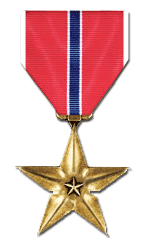
Establishing Authority
The Bronze Star Medal was established by Executive Order 9419 signed by President Franklin D. Roosevelt on February 4, 1944.
Effective Dates
The Bronze Star Medal is retroactive to December 7, 1941.
Criteria
The Bronze Star Medal may be awarded to individuals who, while serving in any capacity with the Armed Forces of the United States in a combat theater, distinguish themselves by heroism, outstanding achievement, or by meritorious service not involving aerial flight.
Order of Precedence
The Bronze Star Medal is worn after the Soldier's Medal (or comparable decoration from the other services), but before the Purple Heart.
Devices
- Army and Air Force: Additional awards are denoted by oak leaf clusters. The "V" device is worn when the Bronze Star Medal is awarded for heroism.
- Navy, Marine Corps and Coast Guard: Additional awards are denoted by gold stars, and the Combat Distinguishing "V" Device may be authorized.
Designer
The Bronze Star Medal was designed by Rudolf Freund of Bailey, Banks and Biddle.
First Recipient
The identity of the first recipient of the Bronze Star Medal is unknown.
Description and Symbolism
Obverse
The medal is a bronze, five-pointed star (point up) one and a half inches in circumscribing diameter. In the center of the star there is a smaller, raised star three-sixteenths of an inch in diameter. The center lines of the arms of both stars coincide. The star design was suggested by the Silver Star medal.
Reverse
In the center of the star in raised letters and forming a circle around the center, the inscription HEROIC OR MERITORIOUS ACHIEVEMENT.
Ribbon
The ribbon is predominantly red with a white-edged blue band in the center and white edge stripes.